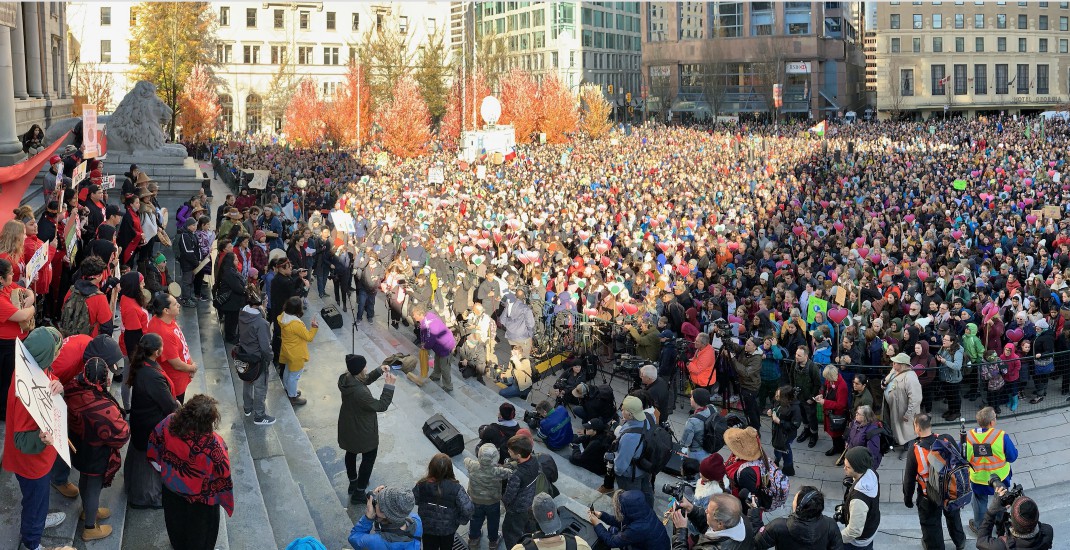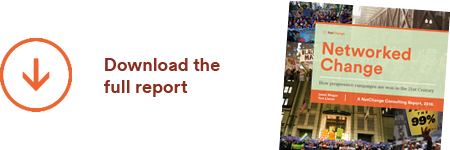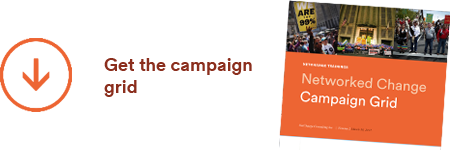Most of the NGO’s I know have come a long way towards making themselves more useful when citizen-led social movements and big change moments (that we work so hard to make happen) actually show up.
But it’s still tricky work to align the gifts centralized orgs bring to the needs of decentralized movements. My good friend Michael Silberman, founder of MobLab, wrote the perfect article on how. It’s packed with great stories and hard-earned wisdom, as so many of us have leaned into this big question over the past decade.
You can read Michael’s article at OpenDemocracy, or below. I really couldn’t say it any better:
Can NGOs and social movements be authentic allies?
Campaigning organisations are moving beyond the question of ‘if’ they should engage with movements to asking ‘when’ and ‘how’ – reflecting an understanding of systems change as complex, nonlinear and unpredictable in which NGOs can have little impact on their own. However, these institutions have a completely different DNA to movements, with heavy layers of decision-making to manage risk, protect a brand, and ensure consistency across staff and offices.
If this weren’t enough to stifle timely, creative collaboration toward shared goals, many NGO staff rightly have an overwhelming fear of causing harm to movements by acting in ways that are (or appear to be) self-serving or co-opting. They also fear causing harm to their own organization through legal risks or supporter attrition. That said, inaction during a ‘movement moment’ also risks an organisation’s relevance and impact.
Here are four things we’ve learned and encourage campaigning organisations to consider:
Get clear on what you mean by movements.
The TckTckTck global climate campaign in 2009 proposed ‘creating a movement’ with a board of leading environmental NGOs. But as one of its coalition members recalled, “I thought out loud and to myself, movements don’t have boards, you knuckleheads.”
It may seem obvious, but how often do we talk about NGO supporters and movements as one and the same? While it’s true that an organisation’s donors, members, and supporters belong to collective movements for change through their actions or affiliations, most nonprofits are not building movements in and of themselves.
As Rhize puts it, “A nonviolent social movement tackles systemic injustices through sustained activation of diverse communities over time. People unite under a common purpose and use collective action to alter current power structures and transform their society.”
The NGOs we admire most are also tackling systemic injustice, inspiring meaningful actions, and building powerful supporter relationships, and that work may contribute to building the collective strength and long-term power of movements. But rarely can an NGO legitimately claim to have catalysed collective action from diverse communities.
Supporters can see when an NGO is loose with its language. “I see a lot of charities in the UK start to talk the language of movement building. I worry that it’s an attempt to rebrand fundraising or list growth,” says engagement strategist Paul de Gregorio, the founder of Rally.
These semantics matter because getting clear on what we mean by movements enables us to have more productive conversations within our organisations and honours the time and painstaking work of true movement builders who don’t enjoy the same resources as NGOs. By contrast, an organisation that lacks fluency in movement fundamentals risks disrespecting the movement leaders and actors with whom it wants to collaborate.
Know when to leave your brand behind.
Most NGO colleagues harbour fears about their organisation’s brand if they engage with or support a movement. These worries range from causing unintentional harm to the movement through their brand’s visibility (e.g. ‘hogging the media spotlight’) to self-inflicted harms like losing donors who oppose the movement’s work.
Others see collaborating with new or untested movements as a positive evolution for many NGO brands, so the question every leadership team needs to reckon with is this: can we leave our brand behind if it helps us meet our mission?
This question became especially poignant for established gun control groups in the US, for example, when youth-led movements like March for Our Lives emerged and quickly achieved an impact. Suddenly, large and diverse groups were taking to the streets and the internet demanding action – and getting results.
This resonated with engagement strategist Diana Pasquali, who worked with Moms Demand Action, the volunteer wing of Everytown for Gun Safety (the US’ biggest gun violence prevention organization). Pasquali suggests that NGOs must learn to support movements while also getting out of the way when the movement is moving forward in a direction that may not fit with their existing donors or campaigns.
Following the Parkland mass shooting, for example, large national groups like Everytown provided background support like logistics and travel funding to support the student-led March for Our Lives – without any presence on stage. To prepare for advantageous ‘movement moments’ like this, NGOs need to work out what they’re willing to risk for the sake of their greater goals.
Movement support work introduces new types of risks which shouldn’t be treated in the same way as others. For example, a child rights group will never risk a child’s safety, but there’s no reason to use such rigorous criteria for deciding on whether staff can attend a youth climate strike as an act of solidarity, relationship building, and power building.
It’s true that collaborating with movements may risk a negative media story about an NGO. It may also mean losing donors who prefer the NGO and its brand not to evolve. But leaders who prioritise impact over institution-building are acknowledging the urgency of the challenges we face. Factoring the long-term value of systems change into analyses of organisational risks will pay off for everyone.
Share your credibility.
Most advocacy organisations have spent years developing their communications and media machines, which can be invaluable in amplifying movement messages, demonstrating solidarity, and helping to shift societal narratives and culture.
Take the 2019 people-powered victory over a proposed coal plant in Lamu on Kenya’s coast as an example. The UN Environment Programme published a case study highlighting how “the community campaign worked with groups across various sectors and outside their locale. Local and foreign environmental and human rights organisations were actively involved.”
In addition to providing legal, financial, and other resources to activists, these groups lent their brands and media influencing capabilities to turn a local fight into a national “deCOALonize” campaign that generated public support across the country.
Another example is Greenpeace’s decision to hand control of its wide-reaching social media channels to #FridaysForFuture students for a day in May 2019 to help them reach more people. “They have asked to use Greenpeace channels to be heard by anyone who is ready to act against the climate emergency – so we are giving it to them,” said Greenpeace International executive director Jennifer Morgan at the time, “We encourage other NGOs to do the same.”
Move money and resources.
Movements are under-resourced. They’re powered by volunteers and leaders whose commitment to the cause often prevents them from having a day job – or even seeing their children regularly. Institutional funding is difficult or impossible to secure because movements are unwilling or unable to comply with traditional grant reporting requirements and procurement, hiring and auditing procedures.
The informal or nontraditional structures on which movements thrive are anathema to most donors, so we need to bridge this gap if we’re all to benefit from the step changes and innovations that movements can bring to social change.
For example, NGOs can advocate for movements with funders and supporters. “Ask donors to match gifts to the organisation with gifts to a movement,” says Randall Smith, founder of PowerLabs. Showing Up for Racial Justice, which mobilises white people to advocate for racial justice, did this by asking its donors to make matching gifts to Black-led movement groups.
That kind of advocacy isn’t always easy, quick or successful. But sometimes sharing your halo means taking a chance. Smith also shared the story of helping netroots groups raise money for a fund controlled by the Movement for Black Lives. Several groups ran tests emailing small segments of their full list, and many pulled out of the project due to poor test results. “The groups that just followed test results missed the opportunity to educate and build support for the movement among white people at a critical time,” says Smith.
NGOs can also lend or contribute other equally valuable resources quickly and easily, like meeting rooms, colour printers, food, Photoshop access, and tear gas masks.“This stuff seems small, but it can make or break important work,” says organiser and MobLab colleague Sarah Ali.
“During a recent blockade against pipelines on stolen Indigenous land, land defenders needed basic things like food, fresh water, better tents, cigarettes, etc. No grantor is giving any movement these things for a 28 day sit-in, and we always have to reach into our communities and networks. These are concrete materials that NGOs can provide, and are also really important gestures of good faith.”
One of the biggest ways NGOs can support movements is through their own staff time. “Let staff go all in to support a movement organization as individuals, not as a coalition partner,” said one colleague. “Staff can embed in an organization and use their expertise to help, plus pull in additional resources – money, people, relationships – to support the movement.”
Lysa John, Secretary General of CIVICUS, suggests that NGOs can help to sustain movement momentum by providing non-residential fellowships for movement leaders and organisers who are dedicating their lives to the cause without any regular income as a way to cover their time, so that they can continue to do what they do best.
In short:
Show up early, and be present without an agenda. Discover what’s needed by being there and listening. Don’t hide your organisational affiliation, but make it clear that you’re not just there in solidarity but also to figure out how else you might be able to contribute. Remember you’re not in charge.
Listen before doing. Each movement needs resources in unique ways. What do organisers need most and where are you authentically well positioned to do – both now and longer term, after public interest has waned?
Be accountable. Consider yourself a part of the movement, not just a spectator or helper. When things go wrong, step into solution mode and own mistakes. Accept responsibility and be willing to take suggestions and constructive advice.
Article by Michael Silberman, Executive Director of MobLab, who do great campaign planning and training. Originally posted on OpenDemocracy.










